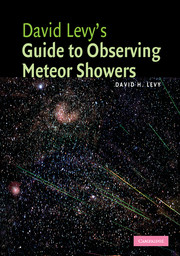Book contents
- Frontmatter
- Contents
- Preface
- 1 July 4, 1956
- 2 What is a meteor?
- 3 Some historical notes
- 4 Small rocks and dust in space
- 5 Observing meteors
- 6 Recording meteors
- 7 A New Year gift: the Quadrantids
- 8 The Lyrids – an April shower
- 9 The Eta Aquarids
- 10 The Omicron Draconids, continued
- 11 The Delta Aquarids
- 12 Tears of St. Lawrence: Perseid trails and trials
- 13 The August Pavonids
- 14 The Orionids
- 15 The Taurids
- 16 The Leonids
- 17 The Geminids
- 18 The Ursids
- 19 A catalog of meteor showers throughout the year
- Appendix
- Index
16 - The Leonids
Published online by Cambridge University Press: 06 July 2010
- Frontmatter
- Contents
- Preface
- 1 July 4, 1956
- 2 What is a meteor?
- 3 Some historical notes
- 4 Small rocks and dust in space
- 5 Observing meteors
- 6 Recording meteors
- 7 A New Year gift: the Quadrantids
- 8 The Lyrids – an April shower
- 9 The Eta Aquarids
- 10 The Omicron Draconids, continued
- 11 The Delta Aquarids
- 12 Tears of St. Lawrence: Perseid trails and trials
- 13 The August Pavonids
- 14 The Orionids
- 15 The Taurids
- 16 The Leonids
- 17 The Geminids
- 18 The Ursids
- 19 A catalog of meteor showers throughout the year
- Appendix
- Index
Summary
This show'r, blown up by tempest of the soul,
Startles mine eyes and makes me more amaz'd
Than had I seen the vaulty top of heaven
Figur'd quite o'er with burning meteors.
As we read in Chapter 3, the Leonid shower has inspired sky watchers way back into the distant past. But it appears that the orbit of the stream changes, probably because of continued influence from Jupiter's gravity. For long periods the densest portion of the stream does not come close enough to the Earth, and then returns for a better strike. Thus, the 1833 and 1866 storms were marvels to behold, but the showers around 1899 were mild, and there was very little in 1933. And so the great Leonid meteor storms, where one meteor per second or more could be seen, entered the realm of history.
The storm of 1966
Thus, the Leonids joined other showers in the weak to moderate category. I recall, however, in one of the first Sky and Telescope magazines I ever received as a child, that the November 1963 shower was a little stronger than expected. The article reminded us of the great storms of the past, and wondered if 1966 might see a return to those levels of history.
The Leonids of 1964 and 1965 were even stronger, and so astronomers awaited the night of November 17, 1966, with considerable anticipation. That Wednesday evening was completely cloudy over most of the northeastern United States.
- Type
- Chapter
- Information
- David Levy's Guide to Observing Meteor Showers , pp. 90 - 95Publisher: Cambridge University PressPrint publication year: 2007



